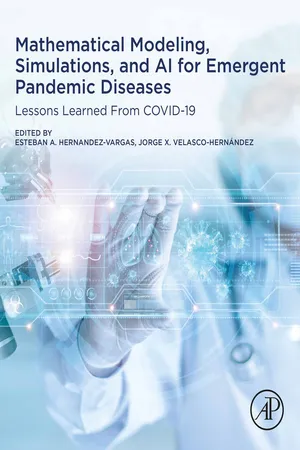
Mathematical Modeling, Simulations, and AI for Emergent Pandemic Diseases
Lessons Learned From COVID-19
Esteban A. Hernandez-Vargas,Jorge X. Velasco-Hernandez, Edgar N. Sanchez
- 348 pages
- English
- ePUB (mobile friendly)
- Only available on web
Mathematical Modeling, Simulations, and AI for Emergent Pandemic Diseases
Lessons Learned From COVID-19
Esteban A. Hernandez-Vargas,Jorge X. Velasco-Hernandez, Edgar N. Sanchez
About This Book
Mathematical Modeling, Simulations, and Artificial Intelligence for Emergent Pandemic Diseases: Lessons Learned from COVID-19 includes new research, models and simulations developed during the COVID-19 pandemic into how mathematical methods and practice can impact future response. Chapters go beyond forecasting COVID-19, bringing different scale angles and mathematical techniques (e.g., ordinary differential and difference equations, agent-based models, artificial intelligence, and complex networks) which could have potential use in modeling other emergent pandemic diseases. A major part of the book focuses on preparing the scientific community for the next pandemic, particularly the application of mathematical modeling in ecology, economics and epidemiology.
Readers will benefit from learning how to apply advanced mathematical modeling to a variety of topics of practical interest, including optimal allocations of masks and vaccines but also more theoretical problems such as the evolution of viral variants.
- Provides a comprehensive overview of the state-of-the-art in mathematical modeling and computational simulations for emerging pandemics
- Presents modeling techniques that go beyond COVID-19, and that can be applied to tailoring interventions to attenuate high death tolls
- Includes illustrations, tables and dialog boxes to explain highly specialized concepts and insights with complex algorithms, along with links to programming code
Frequently asked questions
Information
Table of contents
- Cover image
- Title page
- Table of Contents
- Copyright
- Contributors
- Acknowledgments
- 1: Modeling during an unprecedented pandemic
- 2: Global epidemiology and impact of the SARS-CoV-2 pandemic
- 3: Analysis of an ongoing epidemic: Advantages and limitations of COVID-19 modeling
- 4: On spatial heterogeneity of COVID-19 using shape analysis of pandemic curves☆
- 5: Pandemic response: Isolationism or solidarity?: An evolutionary perspective
- 6: Optimizing contact tracing: Leveraging contact network structure
- 7: Applications of deep learning in forecasting COVID-19 pandemic and county-level risk warning
- 8: COVID-19 population dynamics neural control from a complex network perspective
- 9: An agent-based model for COVID-19 and its interventions and impact in different social phenomena
- 10: Implementation of mitigation measures and modeling of in-hospital dynamics depending on the COVID-19 infection status
- 11: A mathematical model for the reopening of schools in Mexico
- 12: Mathematical assessment of the role of vaccination against COVID-19 in the United States
- 13: Ascertainment and biased testing rates in surveillance of emerging infectious diseases
- 14: Dynamical study of SARS-CoV-2 mathematical models under antiviral treatments
- 15: Statistical modeling to understand the COVID-19 pandemic
- 16: After COVID-19: Mathematical models, epidemic preparedness, and external factors in epidemic management
- Index